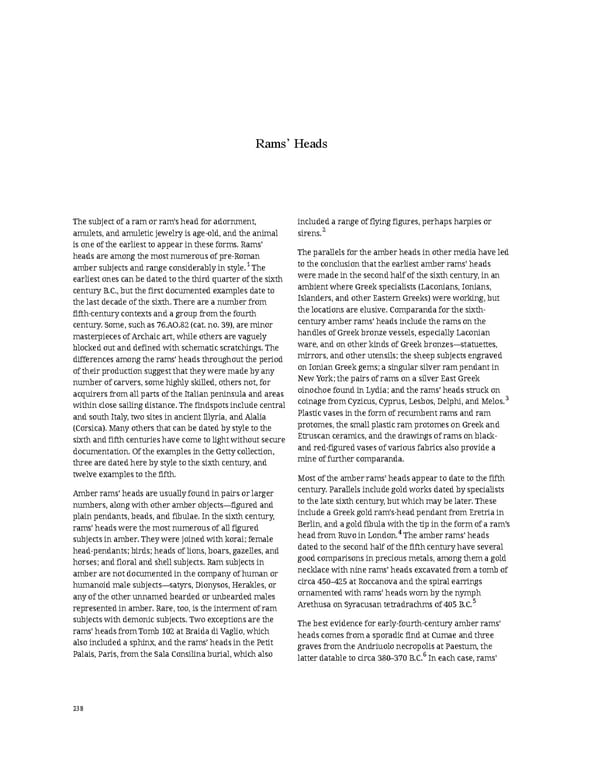Rams’ Heads The subject of a ram or ram’s head for adornment, included a range of flying figures, perhaps harpies or amulets, and amuletic jewelry is age-old, and the animal sirens.2 is one of the earliest to appear in these forms. Rams’ heads are among the most numerous of pre-Roman The parallels for the amber heads in other media have led amber subjects and range considerably in style.1 The to the conclusion that the earliest amber rams’ heads earliest ones can be dated to the third quarter of the sixth were made in the second half of the sixth century, in an century B.C., but the first documented examples date to ambient where Greek specialists (Laconians, Ionians, the last decade of the sixth. There are a number from Islanders, and other Eastern Greeks) were working, but fifth-century contexts and a group from the fourth the locations are elusive. Comparanda for the sixth- century. Some, such as 76.AO.82 (cat. no. 39), are minor century amber rams’ heads include the rams on the masterpieces of Archaic art, while others are vaguely handles of Greek bronze vessels, especially Laconian blocked out and defined with schematic scratchings. The ware, and on other kinds of Greek bronzes—statuettes, differences among the rams’ heads throughout the period mirrors, and other utensils; the sheep subjects engraved of their production suggest that they were made by any on Ionian Greek gems; a singular silver ram pendant in number of carvers, some highly skilled, others not, for New York; the pairs of rams on a silver East Greek acquirers from all parts of the Italian peninsula and areas oinochoe found in Lydia; and the rams’ heads struck on coinage from Cyzicus, Cyprus, Lesbos, Delphi, and Melos.3 within close sailing distance. The findspots include central and south Italy, two sites in ancient Illyria, and Alalia Plastic vases in the form of recumbent rams and ram (Corsica). Many others that can be dated by style to the protomes, the small plastic ram protomes on Greek and sixth and fifth centuries have come to light without secure Etruscan ceramics, and the drawings of rams on black- documentation. Of the examples in the Getty collection, and red-figured vases of various fabrics also provide a three are dated here by style to the sixth century, and mine of further comparanda. twelve examples to the fifth. Most of the amber rams’ heads appear to date to the fifth Amber rams’ heads are usually found in pairs or larger century. Parallels include gold works dated by specialists numbers, along with other amber objects—figured and to the late sixth century, but which may be later. These plain pendants, beads, and fibulae. In the sixth century, include a Greek gold ram’s-head pendant from Eretria in rams’ heads were the most numerous of all figured Berlin, and a gold fibula with the tip in the form of a ram’s head from Ruvo in London.4The amber rams’ heads subjects in amber. They were joined with korai; female head-pendants; birds; heads of lions, boars, gazelles, and dated to the second half of the fifth century have several horses; and floral and shell subjects. Ram subjects in good comparisons in precious metals, among them a gold amber are not documented in the company of human or necklace with nine rams’ heads excavated from a tomb of humanoid male subjects—satyrs, Dionysos, Herakles, or circa 450–425 at Roccanova and the spiral earrings any of the other unnamed bearded or unbearded males ornamented with rams’ heads worn by the nymph Arethusa on Syracusan tetradrachms of 405 B.C.5 represented in amber. Rare, too, is the interment of ram subjects with demonic subjects. Two exceptions are the The best evidence for early-fourth-century amber rams’ rams’ heads from Tomb 102 at Braida di Vaglio, which heads comes from a sporadic find at Cumae and three also included a sphinx, and the rams’ heads in the Petit graves from the Andriuolo necropolis at Paestum, the Palais, Paris, from the Sala Consilina burial, which also latter datable to circa 380–370 B.C.6 In each case, rams’ 238
 Ancient Carved Ambers in the J. Paul Getty Museum Page 247 Page 249
Ancient Carved Ambers in the J. Paul Getty Museum Page 247 Page 249